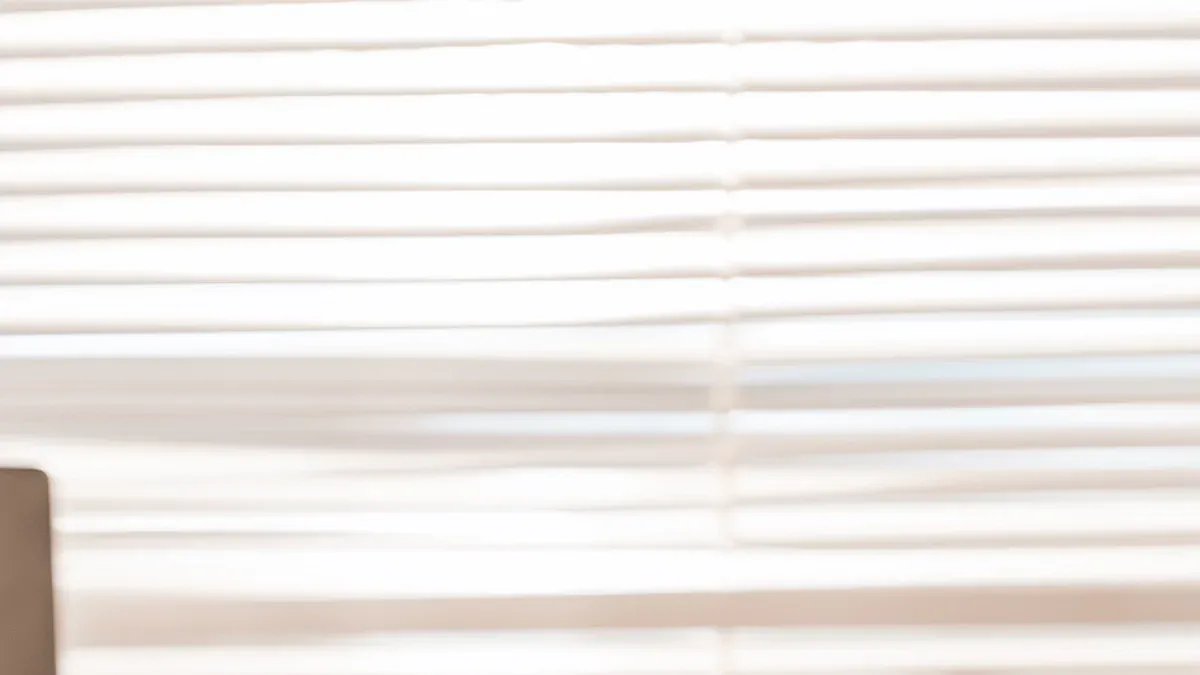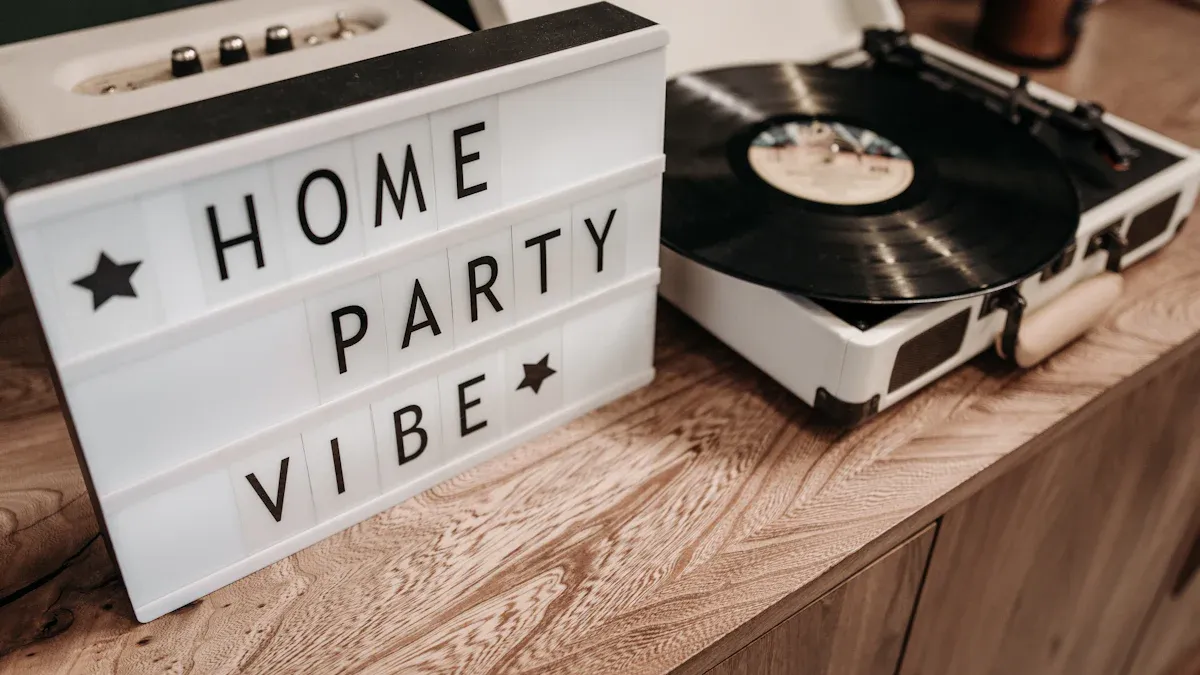Light Boxes for Vinyl: Applications, Types, and Best Practices

When you use light boxes for vinyl, you can be more creative. You can also make your work look more professional. A lightbox has LED lights that shine through vinyl graphics. This makes every detail easy to see. You can use a light box at home for fun projects. You can also use it for your business to make displays stand out. Light boxes make your project look bright and modern. You will see your graphics better during the day and at night. Your graphics will look sharp and clear. A light box helps your business look polished and special. Many people like light boxes because they do not cost too much. They last a long time and keep your message bright all day and night. If you want your vinyl projects to look great, you should use a lightbox.
Key Takeaways
Light boxes help people see vinyl graphics better. They also make displays look more professional. This makes them great for home and business use.
Pick the right light box for your needs. Backlit light boxes are very bright. Edge-lit ones look slim and modern.
Clean your light box often. Check the wires to make sure they work. This helps your display stay bright and last longer.
Use good, see-through vinyl for the best look. This lets light shine through and makes the graphics stand out.
Think about how much money you want to spend. Also, think about how often you will change the graphics. This helps you pick the best light box for your needs.
Light Boxes for Vinyl Overview
What Are Light Boxes for Vinyl
You might wonder what makes light boxes for vinyl so special. These lightbox displays use LED lights to shine through your vinyl graphics, making every detail pop. You can find them in all sorts of places, from stores to trade shows. People love them because they make displays look bright and modern.
Here are some common features you’ll notice in these lightbox displays:
LED backlighting for even, bright light
Durable frames that last a long time
Easy ways to swap out your graphics
Different types for different displays, like wall-mounted or freestanding
Frameless designs for a sleek, clean look
Lightweight aluminum frames that are easy to move
You can use a lightbox for almost any display. It works great for advertising, art, or even science projects. You get a professional look without a lot of hassle.
How Light Boxes Work
A lightbox uses smart technology to make your displays shine. The secret is in the way the light moves through the box and the vinyl. You get bright, even lighting that makes your graphics stand out.
Here’s a quick look at the key parts that help a light box do its job:
Component | Description | Benefits |
|---|---|---|
Backlit Lighting | LEDs sit behind the graphic for even illumination. | Gives you bright, uniform light. |
Edge-lit Lighting | LEDs line the sides, so the frame stays thin and modern. | Saves energy and looks sleek. |
Graphic Material | The vinyl you choose affects how the light spreads and how clear it looks. | Makes your display sharp and colorful. |
You’ll find that the type of lighting, where the LEDs sit, and the design of the lightbox all change how your displays look. Some light boxes use advanced LED technology for better brightness and energy savings. Others use special films to test materials or help with scientific displays. You might even see light boxes used in labs to measure how much light passes through different plastics.
If you want your displays to look their best, pick the right light box and vinyl. You’ll see the difference right away.
Applications and Displays

Light Box Signs
Light box signs are easy to spot in many places. You see them at coffee shops, gas stations, and theaters. These signs use vinyl graphics and bright lights. This helps messages stand out all day and night. You also find them in hospitals, libraries, and stadiums. Businesses use these signs to show their brand and products. The lighting spreads across the vinyl for bright colors and a neat look. Here are some places where you can find these signs:
Application Type | Examples |
|---|---|
Commercial | Business, Bar, Coffee Store, Shop, Office, Restaurant, Hotel, Gas Station, Car Wash Store, Trade Show, Pharmacy, Theater, ATM, Cinema, Corporate, SPA, Shopping Center, Dental Office, Law Office |
Public | Church, Hospital, Museum, Library, Stadium, Laboratory, University |
Indoor | Wall, Lobby, Reception |
Outdoor | Building, Storefront, Architectural |
Light box signs work inside and outside. They last a long time and save energy. The LED lights make your vinyl graphics look bright. Your message will always be easy to see.
Trade Show Displays
Trade shows are busy, so displays need to stand out. You want people to notice your booth fast. Lightbox displays with vinyl graphics help with this. You can show videos, moving pictures, and even interactive things. This keeps people interested and helps you get more leads. Some displays have light frames and big screens. Some booths use double-sided light boxes for a bigger effect.
Model | Size | Features |
|---|---|---|
VK-1977 | 10 x 10 | Lightweight aluminum construction, portable case, supports large monitor. |
VK-4030 | 10 x 20 | Nearly 20 ft. of backlit graphics, large monitor mount, charging table, tablet kiosks. |
GK-5152 | 20 x 20 | Island exhibit with (3) 15 ft. high double-sided lightboxes for maximum impact. |
You see these displays at trade shows, showrooms, and conventions. The bright lights and clear vinyl graphics help your brand stand out.
Retail and Window Displays
Stores use light boxes for vinyl to make window displays pop. You see bright colors that make products look great. The lights behind the vinyl make graphics look real and catch your eye. You find these displays in malls, boutiques, and shopping centers. The even lighting keeps your graphics sharp all day. You get a pro display that brings people in.
Creative and DIY Uses
You can use lightbox displays for fun projects at home or school. Try making light-up signs for parties or events. You might create art or science fair displays. Light boxes let you play with lighting and vinyl graphics. You get a cool way to show your ideas. Some people use light boxes in bus stops or subways for community messages. You can make custom displays for anything you want.
Tip: Using light boxes for vinyl makes your displays look better and brighter. Your graphics will look more pro and easy to see.
Types of Light Box Displays

You have a lot of choices when it comes to light box displays. Each type gives you a different look and feel for your vinyl graphics. Let’s break down the main types so you can pick the best one for your project.
Backlit Light Boxes
Backlit light boxes use LED lights placed right behind your vinyl graphics. This setup gives you high brightness and even lighting across the whole display. You see these in airports, malls, and big retail stores. If you want your light box signs to pop with color and detail, this is a great choice.
Best for: Large displays, retail, and places where you need high brightness.
Lighting quality: Very bright and even. Your graphics look sharp and clear.
Assembly: You need to mount the LEDs behind the acrylic sheet. Make sure you secure the frame and test the lights before you finish.
Display quality: Backlit lightbox frames give you a professional look. You get bold colors and crisp images.
Tip: Backlit light box displays work well for illuminated displays that need to grab attention day or night.
Edge Lit Light Boxes
Edge lit light boxes use LEDs along the edges of the frame. The light spreads across the acrylic sheet and lights up your vinyl from the sides. These lightbox frames are ultra-thin and look modern. You see them in offices, restaurants, and places with limited space.
Best for: Slim displays, menu boards, and places where you want a sleek look.
Lighting quality: Standard brightness. Sometimes you see a glow at the corners.
Assembly: You attach LED strips to the sides of the frame. Make sure the acrylic is clean and graphics are lined up.
Display quality: Edge-lit light box signs look stylish. They save space and energy.
Note: Edge lit light boxes are perfect if you want a thin, lightweight frame for your vinyl graphics.
Fabric SEG Light Boxes
Fabric SEG light boxes use a special fabric with a silicone edge. You press the edge into a groove in the frame. The LEDs light up the fabric from behind or the sides. These lightbox frames give you soft, diffused lighting. You see them in trade shows, showrooms, and creative spaces.
Best for: Large, seamless displays and creative projects.
Lighting quality: Moderate brightness. The light feels soft and even.
Assembly: Stretch the fabric and press the silicone edge into the frame. Make sure the fabric is smooth.
Display quality: Fabric seg light boxes give you a modern, frameless look. Your graphics look smooth and bold.
Tip: Fabric SEG light boxes are easy to update. You can swap out graphics fast for new promotions.
Snap Frame Light Boxes
Snap frame light boxes have frames that snap open and closed. You can change your vinyl graphics in seconds. These lightbox frames are popular in restaurants, movie theaters, and retail stores.
Best for: Places where you need to change graphics often.
Lighting quality: Moderate brightness. The light is even but not as strong as back-lit light box displays.
Assembly: Open the frame, place your graphic, and snap it shut. It’s quick and easy.
Display quality: Snap frame light boxes keep your graphics secure. They work well for menus, posters, and ads.
Note: Snap frame light boxes are great for busy spots where you want to update your message often.
LED Light Box Signs
LED light box signs use advanced LED technology for high brightness and low energy consumption. You see these lightbox frames everywhere, from outdoor lightbox frames to indoor displays. They come in many shapes and sizes.
Best for: Both indoor and outdoor lightbox frames, and any place you want high brightness and energy savings.
Lighting quality: Very bright and energy-efficient. Your graphics look vibrant.
Assembly: Mount the LED strips, secure the frame, and test the lights. These lightbox frames are built to last.
Display quality: LED light box signs give you sharp, colorful images. They work well for branding and advertising.
Tip: LED light box signs are a smart choice if you want high brightness and low energy bills.
Comparing Illumination, Assembly, and Display Quality
Here’s a quick table to help you compare the main types of light box displays:
Light Box Type | Brightness | Energy Efficiency | Design Characteristics |
|---|---|---|---|
Edge Lit | Standard | High | Ultra-thin, may have glow on corners |
Backlit | High | Low | Needs space for bulbs, even light distribution |
Fabric SEG | Moderate | Moderate | Soft, diffused light, seamless look |
Snap Frame | Moderate | Moderate | Easy to change graphics, less focus on light |
LED Light Box Signs | High | High | Bright, energy-efficient, versatile |
How to Assemble Light Box Signs
You might wonder how to put these lightbox frames together. Here’s a simple step-by-step list:
Prepare your sign parts. Cut the frame and back panel to the right size.
Cut and clean the acrylic sheet. Handle it carefully to avoid scratches.
Get your vinyl graphics ready. Apply them with care so they line up right.
Mount the lighting system inside the frame. Spread the LED strips evenly.
Place the acrylic and graphics in the frame. Make sure everything fits tight.
Secure the frame and back panel. Use strong tape or fasteners.
Test the LED lights. Install the power system and mount your sign.
Cost of Light Box Displays
Prices for light boxes for vinyl can vary. Some companies offer premium, waterproof lightbox frames for $158 to $591. Others sell handmade or foldable light box signs starting at $94. Custom features and outdoor lightbox frames can cost more. You get what you pay for in terms of lighting quality and durability.
Tip: When you choose a lightbox, think about your budget, how often you’ll change graphics, and where you’ll use the display.
You have many options for light box displays. Each type gives you a different look, lighting quality, and assembly process. Pick the one that fits your needs, and your vinyl graphics will always stand out.
Choosing and Using Light Boxes
Selection Tips
Picking the right lightbox for your vinyl project can feel tricky, but you can make it simple by focusing on a few key things. First, think about the type of vinyl you want to use. Digital vinyl lets you match colors easily, but it may fade faster. Cut vinyl lasts longer, but you need to apply it carefully. Always check if the vinyl color matches your design and works well with your lighting.
You should also look at the durability of both the vinyl and the light box. If your display will face the weather, pick waterproof and UV-resistant vinyl. Translucent vinyl works great for outdoor light box signs because it keeps colors bright and clear.
When you choose a lightbox, pay attention to these factors:
Lighting: Make sure the placement and intensity of the led light source give you even illumination. Uneven lighting can make your graphics look dull.
Color: Pick colors that fit your brand and stand out under the lighting.
Typography: Use fonts that are easy to read and match your brand style.
Size and Shape: The light box should fit your space and not look out of place.
Here’s a quick table to help you decide on size and brightness:
Factor | Recommendation |
|---|---|
Dimensions | A4 for portable displays; A3 or A2 for bigger light box signs. |
Luminosity | At least 3000 lux for tracing; 1500-3000 lux for general displays. |
Color Temperature | Around 6500 K for true color; higher for more focus and clarity. |
Tip: If you want high-impact advertisements, use a lightbox with strong lighting and vibrant vinyl colors.
Installation Basics
Setting up light box displays does not have to be hard. You just need to follow a few steps and pay attention to details. Start by making sure your lightbox frames are level before you attach them. If you skip this, your display might look crooked after you finish.
Here are some common installation challenges:
Placing and leveling the light boxes before you add siding or other finishes.
Managing cable slack so you can adjust the box later if needed.
Avoiding boxes that are out of level, which you might not notice until the end.
For a safe and sturdy installation, use mounting blocks made for vinyl siding. Always follow electrical safety rules when you connect the led light source. Do not remove too much siding, or you could weaken the installation.
Note: Double-check your work as you go. It is easier to fix small problems early than to redo the whole setup.
Lighting and Material Compatibility
The right lighting can make your vinyl graphics look amazing. Backlit vinyl works best for light box signs because it spreads light evenly and makes colors pop. Even in low light, your display will stay bright and clear.
You have a few material options for your lightbox frames:
Duratran transparency film: This film is perfect for backlit displays. It brings out color details when you turn on the lighting.
SEG (Silicone Edge Graphics) fabric: You need a special frame for this, but it gives you bold, vibrant displays.
Translucent vinyl: This material is waterproof and UV-resistant. It keeps your graphics looking sharp in any weather and sticks well to surfaces like acrylic.
Tip: Always test your vinyl and lighting together before you finish your advertising light box. This helps you spot any problems with color or brightness.
Maintenance and Cleaning
Keeping your light box displays in top shape is easy if you follow a routine. Clean the outside and the diffuser every week to keep the lighting clear. Check the ventilation so your lightbox does not overheat. Look at the electrical connections to make sure everything works right.
Here is a simple maintenance schedule:
Maintenance Type | Frequency | Description |
|---|---|---|
Surface Cleaning | Weekly | Wipe down the exterior and diffuser for clear lighting. |
Ventilation Check | Weekly | Make sure nothing blocks the vents. |
Electrical Check | Weekly | Check all wires and connections. |
Internal Inspection | Monthly | Look at the led light source and power supply for damage. |
Deep Cleaning | Monthly | Clean inside, especially reflective parts, for the best lighting. |
Comprehensive Check | Quarterly | Inspect all hardware and electrical parts. |
Functionality Test | Quarterly | Test all controls and dimming features. |
Component Replacement | Annual | Swap out any worn or broken parts. |
Calibration | Annual | Adjust lighting settings for steady performance. |
For cleaning, use safe products like isopropyl alcohol, ethanol, glycerine, hydrogen peroxide, or a mild detergent with water. Stay away from soaps with wax, oil, or lotion. Dust the screen with a soft cloth and use a cover to protect your lightbox frames from dirt and spills.
Tip: Regular care keeps your advertising light box looking new and your displays shining bright.
Common Mistakes
Even if you follow all the steps, you might run into problems with your light box signs. Here are some mistakes people make and how you can fix them:
Forgetting to check the power source. Always make sure the cord is plugged in tight.
Not replacing burned-out LED bulbs. Swap them out as soon as you notice.
Placing LED strips unevenly. Move them so the lighting spreads out smoothly.
Using a low-quality diffuser. Upgrade to a better one for even light.
Ignoring the power supply. Make sure it is stable and strong enough for your lightbox frames.
Letting dirt build up on the screen. Clean it often to keep your display clear.
Skipping regular inspections. Look for worn parts and replace them before they break.
If you see uneven lighting, adjust the LED placement or get a better diffuser. Flickering lights usually mean you need to check the power supply or look for interference. Always keep your advertising light box clean and check for damage.
Note: A little attention goes a long way. Your light box signs will last longer and look better if you keep up with care and fixes.
You now have the tools to choose, install, and care for your light boxes for vinyl. With the right lighting, materials, and routine, your lightbox frames will help your displays stand out in any setting.
Choosing the right lightbox frames for your vinyl projects makes a big difference. You want lightbox frames that fit your needs, last a long time, and look great. Always check if your lightbox frames work with your vinyl and can handle heat. Use lightbox frames that match your budget and style. Clean your lightbox frames often and protect them from sunlight. Try different lightbox frames to see what works best. When you follow these tips, your lightbox frames will help your displays shine. Upgrade your lightbox frames today and watch your vinyl graphics stand out!
FAQ
How do you clean a light box for vinyl?
You can wipe the surface with a soft cloth. Use mild soap and water. Avoid harsh chemicals. Make sure the light box is unplugged before you start cleaning.
Can you use any vinyl with a light box?
You should use translucent or backlit vinyl. These types let light pass through and make your graphics look bright. Regular vinyl might block the light and look dull.
What size light box works best for home projects?
A4 or A3 size light boxes work well for small projects. You can move them easily and store them without trouble. Bigger sizes fit large displays or signs.
Do light boxes use a lot of electricity?
Most light boxes use LED lights. LEDs save energy and last a long time. You will not see a big increase in your electric bill.
Can you change the graphics on a light box?
Yes! Many light boxes let you swap graphics quickly. Snap frame and SEG light boxes make it easy. You can update your display whenever you want.
See Also
Exploring Acrylic Light Boxes: Uses, Advantages, and Buying Guide
Understanding Acrylic LED Light Boxes: Varieties, Uses, and Setup
Acrylic Photo Light Boxes: Varieties, Advantages, and Innovative Uses
Tailored Acrylic Light Boxes: Design Options, Materials, and Setup
Illuminated Acrylic Display Boxes: Varieties, Characteristics, and Uses

